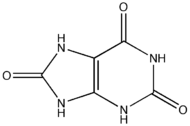
Urate oxidase
Encyclopedia
The enzyme urate oxidase (UO), or uricase or factor-independent urate hydroxylase, catalyzes the oxidation of uric acid
to 5-hydroxyisourate
:
s. The enzyme exists as a tetramer of identical subunits, each containing a possible type 2 copper-binding site.
Urate oxidase is a homotetrameric enzyme containing four identical active sites situated at the interfaces between its four subunits. UO from A. flavus
is made up of 301 residues and has a molecular weight of 33438 dalton. It is unique among the oxidase
s in that it does not require a metal atom or an organic co-factor for catalysis
. Sequence analysis of several organisms has determined that there are 24 amino acids which are conserved, and of these, 15 are involved with the active site.
to mammals, and plays different metabolic roles, depending on its host organism, it is absent in humans and many other primates.
Humans do have a gene
for UO, but it is nonfunctional, a consequence purported to be due to an occurrence of a mutational event early in primate evolution
. Uric acid is, thus, the end product of catabolism
of purine
s in humans.
It has also been proposed that the loss of this UO protein expression
has been advantageous to hominids, since uric acid is a powerful antioxidant
and scavenger of singlet oxygen and radical
s. Its presence provides the body with protection from oxidative damage, thus prolonging life and decreasing age-specific cancer rates. However, this is highly unlikely as proteins are capable of being activated only when concentrations exceed a certain amount. Adequate uric acid levels could still be maintained to protect the body while preventing evolutionarily disadvantageous conditions like gout.
Excessive concentrations of uric acid accumulated in the blood stream, however, leads to gout
. UO has been formulated as a protein drug (rasburicase
) for the treatment of acute hyperuricemia
in patients receiving chemotherapy
. A PEGylated
form of UO is in clinical development for treatment of chronic hyperuricemia in patients with "treatment-failure gout".
occurs in the root nodules of legumes. The fixed nitrogen is converted to metabolite
s that are transported from the roots throughout the plant to provide the needed nitrogen for amino acid
biosynthesis.
In legumes, 2 forms of uricase are found: in the roots, the tetrameric form; and, in the uninfected cells of root nodules, a monomeric form, which plays an important role in nitrogen-fixation.
Uric acid
Uric acid is a heterocyclic compound of carbon, nitrogen, oxygen, and hydrogen with the formula C5H4N4O3. It forms ions and salts known as urates and acid urates such as ammonium acid urate. Uric acid is created when the body breaks down purine nucleotides. High blood concentrations of uric acid...
to 5-hydroxyisourate
5-hydroxyisourate
5-Hydroxyisourate is a molecule with a formula of C5H4N4O4 and molecular weight of 184.110 g/mol. It is the product of the oxidation of uric acid by urate oxidase.-See also:* Urate oxidase* Glycolaldehyde...
:
- Uric acidUric acidUric acid is a heterocyclic compound of carbon, nitrogen, oxygen, and hydrogen with the formula C5H4N4O3. It forms ions and salts known as urates and acid urates such as ammonium acid urate. Uric acid is created when the body breaks down purine nucleotides. High blood concentrations of uric acid...
+ O2 + H2O → 5-hydroxyisourate5-hydroxyisourate5-Hydroxyisourate is a molecule with a formula of C5H4N4O4 and molecular weight of 184.110 g/mol. It is the product of the oxidation of uric acid by urate oxidase.-See also:* Urate oxidase* Glycolaldehyde...
+ H2O2Hydrogen peroxideHydrogen peroxide is the simplest peroxide and an oxidizer. Hydrogen peroxide is a clear liquid, slightly more viscous than water. In dilute solution, it appears colorless. With its oxidizing properties, hydrogen peroxide is often used as a bleach or cleaning agent...
→ allantoinAllantoinAllantoin is a chemical compound with formula C4H6N4O3. It is also called 5-ureidohydantoin or glyoxyldiureide. It is a diureide of glyoxylic acid....
+ CO2
 |
 |
Structure
Urate oxidase is mainly localised in the liver, where it forms a large electron-dense paracrystalline core in many peroxisomePeroxisome
Peroxisomes are organelles found in virtually all eukaryotic cells. They are involved in the catabolism of very long chain fatty acids, branched chain fatty acids, D-amino acids, polyamines, and biosynthesis of plasmalogens, etherphospholipids critical for the normal function of mammalian brains...
s. The enzyme exists as a tetramer of identical subunits, each containing a possible type 2 copper-binding site.
Urate oxidase is a homotetrameric enzyme containing four identical active sites situated at the interfaces between its four subunits. UO from A. flavus
Aspergillus flavus
Aspergillus flavus is a fungus. It is a common mold in the environment, and can cause storage problems in stored grains. It can also be a human pathogen, associated with aspergillosis of the lungs and sometimes causing corneal, otomycotic, and nasoorbital infections. Many strains produce...
is made up of 301 residues and has a molecular weight of 33438 dalton. It is unique among the oxidase
Oxidase
An oxidase is any enzyme that catalyzes an oxidation-reduction reaction involving molecular oxygen as the electron acceptor. In these reactions, oxygen is reduced to water or hydrogen peroxide ....
s in that it does not require a metal atom or an organic co-factor for catalysis
Catalysis
Catalysis is the change in rate of a chemical reaction due to the participation of a substance called a catalyst. Unlike other reagents that participate in the chemical reaction, a catalyst is not consumed by the reaction itself. A catalyst may participate in multiple chemical transformations....
. Sequence analysis of several organisms has determined that there are 24 amino acids which are conserved, and of these, 15 are involved with the active site.
Significance of absence in humans
While UO can be found in an extensive variety of organisms, from bacteriaBacteria
Bacteria are a large domain of prokaryotic microorganisms. Typically a few micrometres in length, bacteria have a wide range of shapes, ranging from spheres to rods and spirals...
to mammals, and plays different metabolic roles, depending on its host organism, it is absent in humans and many other primates.
Humans do have a gene
Gene
A gene is a molecular unit of heredity of a living organism. It is a name given to some stretches of DNA and RNA that code for a type of protein or for an RNA chain that has a function in the organism. Living beings depend on genes, as they specify all proteins and functional RNA chains...
for UO, but it is nonfunctional, a consequence purported to be due to an occurrence of a mutational event early in primate evolution
Evolution
Evolution is any change across successive generations in the heritable characteristics of biological populations. Evolutionary processes give rise to diversity at every level of biological organisation, including species, individual organisms and molecules such as DNA and proteins.Life on Earth...
. Uric acid is, thus, the end product of catabolism
Catabolism
Catabolism is the set of metabolic pathways that break down molecules into smaller units and release energy. In catabolism, large molecules such as polysaccharides, lipids, nucleic acids and proteins are broken down into smaller units such as monosaccharides, fatty acids, nucleotides, and amino...
of purine
Purine
A purine is a heterocyclic aromatic organic compound, consisting of a pyrimidine ring fused to an imidazole ring. Purines, including substituted purines and their tautomers, are the most widely distributed kind of nitrogen-containing heterocycle in nature....
s in humans.
It has also been proposed that the loss of this UO protein expression
Protein expression
Protein expression is a subcomponent of gene expression. It consists of the stages after DNA has been translated into polypeptide chains, which are ultimately folded into proteins...
has been advantageous to hominids, since uric acid is a powerful antioxidant
Antioxidant
An antioxidant is a molecule capable of inhibiting the oxidation of other molecules. Oxidation is a chemical reaction that transfers electrons or hydrogen from a substance to an oxidizing agent. Oxidation reactions can produce free radicals. In turn, these radicals can start chain reactions. When...
and scavenger of singlet oxygen and radical
Radical (chemistry)
Radicals are atoms, molecules, or ions with unpaired electrons on an open shell configuration. Free radicals may have positive, negative, or zero charge...
s. Its presence provides the body with protection from oxidative damage, thus prolonging life and decreasing age-specific cancer rates. However, this is highly unlikely as proteins are capable of being activated only when concentrations exceed a certain amount. Adequate uric acid levels could still be maintained to protect the body while preventing evolutionarily disadvantageous conditions like gout.
Excessive concentrations of uric acid accumulated in the blood stream, however, leads to gout
Gout
Gout is a medical condition usually characterized by recurrent attacks of acute inflammatory arthritis—a red, tender, hot, swollen joint. The metatarsal-phalangeal joint at the base of the big toe is the most commonly affected . However, it may also present as tophi, kidney stones, or urate...
. UO has been formulated as a protein drug (rasburicase
Rasburicase
Rasburicase is a recombinant version of a urate oxidase enzyme that occurs in many mammals but not in humans.-Uses:Rasburicase is approved for use by the U.S...
) for the treatment of acute hyperuricemia
Hyperuricemia
Hyperuricemia is a level of uric acid in the blood that is abnormally high. In humans, the upper end of the normal range is 360 µmol/L for women and 400 µmol/L for men.-Causes:...
in patients receiving chemotherapy
Chemotherapy
Chemotherapy is the treatment of cancer with an antineoplastic drug or with a combination of such drugs into a standardized treatment regimen....
. A PEGylated
PEGylation
PEGylation is the process of covalent attachment of polyethylene glycol polymer chains to another molecule, normally a drug or therapeutic protein. PEGylation is routinely achieved by incubation of a reactive derivative of PEG with the target macromolecule...
form of UO is in clinical development for treatment of chronic hyperuricemia in patients with "treatment-failure gout".
In legumes
UO is also an essential enzyme in the ureide pathway, where nitrogen fixationNitrogen fixation
Nitrogen fixation is the natural process, either biological or abiotic, by which nitrogen in the atmosphere is converted into ammonia . This process is essential for life because fixed nitrogen is required to biosynthesize the basic building blocks of life, e.g., nucleotides for DNA and RNA and...
occurs in the root nodules of legumes. The fixed nitrogen is converted to metabolite
Metabolite
Metabolites are the intermediates and products of metabolism. The term metabolite is usually restricted to small molecules. A primary metabolite is directly involved in normal growth, development, and reproduction. Alcohol is an example of a primary metabolite produced in large-scale by industrial...
s that are transported from the roots throughout the plant to provide the needed nitrogen for amino acid
Amino acid
Amino acids are molecules containing an amine group, a carboxylic acid group and a side-chain that varies between different amino acids. The key elements of an amino acid are carbon, hydrogen, oxygen, and nitrogen...
biosynthesis.
In legumes, 2 forms of uricase are found: in the roots, the tetrameric form; and, in the uninfected cells of root nodules, a monomeric form, which plays an important role in nitrogen-fixation.

